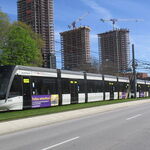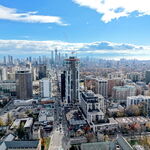Imagine GO having to setup a commuter network in Kingston and London. Not going to happen anytime soon. Nor will GO extend sufficiently past Durham to matter. And if GO did, the required subsidies would be massive compared to VIA.
Don't bet too soon,
Ontario is funding an EA for high speed trains on TKL.
If Ontario operates it, it might fall on Metrolinx.
The GO 2020 document did not even have Kitchener or Niagara service.
Today, GO is serving both (the latter seasonally and soon yearround).
Metrolinx operated HSR would have way more popular electorate support in 2018 and 2022 than UPX.
Assuming the UPX situation has sufficiently recovered by then, to the public's satisfaction (Arguably, not all Metrolinx projects are bad -- there has been some really, really, really nice GO improvements like half-hourly all-day two-way Lakeshore... And I would expect TTC-fare Eglinton Crosstown LRT to be very popular when it starts). There are already enough sensible Metrolinx projects with shovels in ground, that if they perform popularly, can put the UPX debacle behind us by #elxn2018 or #elxn2022.
What's not to say we have a TGV (high speed GO RER bullet expresses?) and Eurostar (high speed VIA) trains sharing different shorter and longer subsets of the same HSR corridor, much like French domestic TGV and international Eurostar trains?
I'm curious how this gets implemented. A big part of the sell for any new development would be through trains at Union running to Pearson at least. But if electrification is on the table, then we have an opportunity for through service with the same trains, with just higher running speeds on the TKL sector.
Ontario might operate it if they won a campaign in 2018 or 2022 to begin construction in the late 2020s for Kitchener operations in the early 2030s and London operations in the later 2030s. By then, London will have their rapid transit and LRT, and KW will be well developed, both sufficiently densities to meet HSR break even.
Essentially, high speed GO commuter trains, perhaps. 70 minutes to London is less than today's Kitchener trains, and fares competitive to VIA Tuesday fare (when buying a pack at least, for frequent commutes). Europe HSR gets much cheaper for frequent commuters, despite being similar to airfare for single purchases (albeit with much more convenient station location than distant RyanAir airports). We spend $5 billion for a new transit route that will have TTC fare (even if zone based by then), the same funds can stil create a HSR route that only has one order magnitude higher fares, especially if it avoids further 401 widenings.
GO RER electrification to Kitchener can pave way for incremental upgrades leading up to Metrolinx operated HSR with relatively good fare box recovery (by then). Two way all day service is a Goal that will be a megaproject thst probably could be combined with electrification. The same RER Phase II spending could pave way towards high speed service in an express-allstop scheme (RER/HSR) using KW initially and London incrementally (along with the Guelph HSR bypass, but keeping the Guelph infra improvements for the faster all stop service).
Who knows -- "GO Pearson" could be a new mainline station near Woodbine racetrack, with a theoretical LINK upgrade running on a future-discounted the UPX spur, to connect everyone (GO RER/ST and HSR) to both airport terminals. Or give free UPX connecting service at Woodbine for HSR users (if UPX still running). Or use existing frequent RER service over the spur if RER(+SmartTrack) replaces UPX during electrification. Many possible solutions to reasonably cost effectively hook TKL HSR to Pearson without redirecting a rail corridor. Personally, I like a theoretical LINK refurbishment/upgrade (faster/longer) to connect Woodbine GO (VIA+RER/ST+HSR) to both Terminals 1 and 3, but any number of options are possible in a generation.
Regardless of GO or VIA, eventually, the HSR lure will gradually be too irresistible and will happen on TKL by the 2040s in my opinion. The electorate is increasingly demanding it, being the corridor with the necessary density and transit deploymeant+mentality (in one generation from now) to warrant it.
Kids are getting fewer driving licenses and the demand (after lots of rapid transit expansions in L, K, T) will be incredible on TKL in 20 years. The bus traffic is already big between KW-Toronto and already fills a few HSR trainsets today. It really can only increase in the post-LRT era. Train use will grow faster than proportional to predicted population growth.
TKL (2030s) is
MUCH more viable (fare box recovery wise) for HSR than the TOM corridor due to the much bigger commuter catchment (above and beyond tourists) given rapid transit in all of T,K,L cities.
Again I personally prefer TOM high speed trains. Ottawa is my hometown! But I am being honest and pragmatic/realistic with data warranting TKL-before-TOM for any services in the 200-300kph range.



